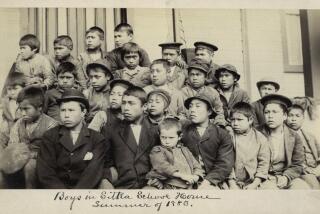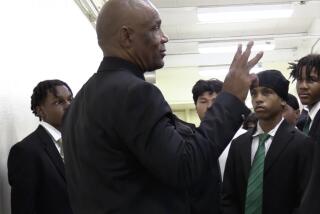The Life Story of an American High School : THE WORLD WE CREATED AT HAMILTON HIGH 1953-1987:<i> by Gerald Grant (Harvard University Press: $24.95; 304 pp.) </i>
Gerald Grant gives the education furies two books in one. The first is a graceful, human, engaging narrative of what happened to an American High School during successive decades of optimism, integration, student upstarting and declining results. Book 1 has heart and mind. The second is an analysis of other writersâ researches, generally validating what Grant learned and saw for himself at high school. Book 2 reads like four chapters of footnotes, germane and useful but about as stirring as the opening-day lecture from a teacher of mechanical drawing.
The first half is full of manic verbs and specific drama, including one principal who suffered a heart attack on active duty and another who was benched by a skull fracture. The second half slows in semantics; the word ethos --the common values of a community--appears seven times on a single page describing the character of different schools.
Yet here is a history of what went right and wrong and then almost right again in the tempestuous course of American public secondary education. Hamilton High is a real place wearing a phony name to protect its people and property. It was built in the 1950s to serve the upper-middle- class neighborhood of a growing northeastern city. Times were good. Boy students wore crew-cuts; girl students wore skirts--and often pearls.
Desegregation arrived in the mid-â60s, by bus. Many white families resented the intrusion. Many black families disliked the long rides to Hamilton. âThe irony of desegregation for black students,â writes Grant, âwas that it brought them together with whites only to increase their sense of distance.â Instead of one student body, there were two--an affluent crowd in the pre-college classes and a relatively poor black crowd resegregated into vocational tracks. In a national climate of assassinations and riots, riots and violence invaded high school.
The â70s were punctuated by a variety of strains: student power; sexual freedom; decreased disciplinary action; lawsuits against school systems, and a new faculty full of young teachers who were often part of the problem. Students constructed their own curricula, and test scores dropped while absenteeism and drug abuse soared. Children decided to go to work instead of to school, well-to-do children among them.
The pendulum swung back by the beginning of the â80s. Black students and white students were no longer hostile toward each other at Hamilton. They had attended the lower grades together and now came to high school as old acquaintances, even as friends. Asian students arrived in significant numbers, bringing with them the seriousness of family aspirations and devotion to education. Test scores began rising, especially among blacks. âHamilton High students,â writes Grant, âhad not returned to the respectful and obedient mode of the 1950s and early 1960s, but they were no longer psychologically in charge, either. The revolt was over.â Adult authority returned, helped by new laws and a new competitive context in the larger culture. But school was a place without spirit, without what Grant calls âa positive ethos.â
The author, a Syracuse University professor, was more than a sometime visitor. Grant and five research assistants spent a few days in each of 33 public and private schools across the country. Then they spent the next academic year immersed at five campuses, asking selected teachers and students to keep journals while the researchers were attending classes, faculty meetings and student events. Grant would discover that, âOne of the ironies of our present predicament may be that only the private school has a public,â a meeting of parent, administration, faculty and student minds dedicated to the values--moral and intellectual--of the school.
He went to an integrated public school, Hamilton, as a teacher in 1984, to validate the way it represented decades of educational turmoil, to elicit faculty participation in recommending needed reforms and to gather first-person testimony for his book. Four national trends had been reflected at Hamilton from the â50s into the â80s: Disorder and drug use rose and then declined. Academic demands dropped as students negotiated their own programs. Absenteeism and drop-out rates increased. Student achievement fell for almost two decades and then began showing some improvement in the â80s.
The good news of recent years, including successful integration, did not return Hamilton to the happier times of the early â50s, when the administration and faculty felt that the school and its most important end product, educated students, was not only their responsibility but their domain. Responsibility had been diffused, sometimes claimed by legislators, by school boards, by parent groups or by outside consultants in the guise of âexperts.â âPrincipals have become middle managers,â claims Grant, âwho process directives issued from a multilayered bureaucracy.â Teachers have become civil servants, following guidelines from afar, serving time but not necessarily serving the needs of students.
Grant offers two âessential reformsâ to restore the necessary intellectual and moral foundation for learning: âFirst, let the schools shape their own destiny; second, put teachers in charge of their own practice.â Let central authority set broad curriculum standards. But let the public school once again become the place where educators and their charges build a community of interest. Let teachers once again make a world within a schoolyard.
Here is an argument for local control buttressed by intimate witness. Here is a survey course in what went wrong when everybody but teachers claimed to know best. Fine primer. A superb case history of what is probably the noblest American dream--education for everybody--only slightly dulled for the lay reader by too many findings from too many outside âexperts.â
More to Read
Sign up for our Book Club newsletter
Get the latest news, events and more from the Los Angeles Times Book Club, and help us get L.A. reading and talking.
You may occasionally receive promotional content from the Los Angeles Times.








